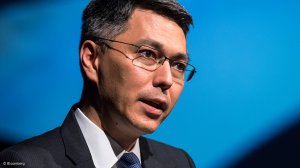JOHANNESBURG (miningweekly.com) – Johannesburg-listed diversified mining major BHP has an exciting growth path ahead in potash used in fertilisers essential for food security and more sustainable farming, the company’s CEO Mike Henry said in his 2023 annual general meeting (AGM) speech.
Earlier, BHP chairperson Ken MacKenzie also emphasised the growing importance to the world of potash in his AGM address.
Against the backdrop of a growing global population, Henry described the long-term fundamentals for the potash market as being compelling.
Moreover, potash prospects, he said, had improved further since BHP sanctioned the first stage of its entry into potash at Jansen in Canada’s Saskatchewan, where the potash sector, Mining Weekly can report, accounts for about 11% of provincial gross domestic product. Saskatchewan's potash production recently reached a record 14.2-million tonnes and the value of sales a record $7.6-billion.
BHP’s Stage 1 project at Jansen, now 32% complete, remains on budget and ahead of its original schedule, with first production expected late in 2026 calendar.
Stage 2 of Jansen, into which a further $4.9-billion is being invested, highlights the confidence in potash and marks the next phase of the company’s growth in Canada.
The latest investment will help to transform Jansen into a large potash mine, doubling production capacity to 8.5-million tons a year, and positioning BHP as a key global potash participant.
“We're able to deliver Stage 2 at a lower capital intensity because of the infrastructure delivered in Stage 1,” added Henry, about an asset that is poised to create value for generations to come.
BHP has also increased its copper and nickel prospects globally through Oak Dam in South Australia, Kabanga Nickel in Tanzania, and Ocelot in the US. They also include projects in Serbia and Peru, and the Filo del Sol project in Argentina and Chile.
The coal portfolio has been consolidated through the divestment of up to $4.1-billion in the Blackwater and Daunia mines, which is expected to be completed in the fourth quarter of the 2024 financial year.
MacKenzie, who plans to lead Australia's biggest company until at least 2025, spoke of mining, and BHP, having a clear role in the critical global energy transition required for more sustainable development.
He reiterated the essential role mined metals and minerals must play in decarbonisation, the energy transition and meeting the demands of a growing population, who are increasingly urbanised and seeking a higher standard of living.
“Over the last three years, we’ve made strategic decisions to reshape our portfolio to align with these global megatrends,” he added.
BHP’s portfolio includes copper for renewable energy, nickel for electric vehicles and iron-ore for the steel required to build decarbonisation and other new infrastructure.
“We also continued to produce strong margins and a consistently high baseline of cash flow.
"Over the past decade, we have delivered average margins of 55% and generated average net operating cash flows of $20-billion US dollars a year,” McKenzie highlighted.
BHP has a Scope 1 and 2 decarbonisation target of at least a 30% reduction in operational greenhouse gas emissions by the 2030 financial year compared with its baseline 2020 financial year.
In the 2023 financial year, it further reduced operational emissions by 11% from the previous year, and remains on track to achieve its 2030 target.
“Our future progress towards greenhouse gas emissions reductions won't be linear as we look to grow our business, but we have a comprehensive plan that is underpinned by clear actions that support emissions reduction now and through to the 2030 financial year.
“Our relationships with Traditional Owners and other Indigenous partners are some of the most important relationships to BHP. We operate on the traditional lands of Indigenous peoples at many of our locations in Australia and around the world. We partner widely with Indigenous communities and have long-term agreements with Traditional Owners and First Nations partners,” MacKenzie pointed out.
BHP has around 8% Indigenous employment in Australia, close to 10% in Chile, and approacing 8% at Jansen.
EMAIL THIS ARTICLE SAVE THIS ARTICLE ARTICLE ENQUIRY
To subscribe email subscriptions@creamermedia.co.za or click here
To advertise email advertising@creamermedia.co.za or click here











